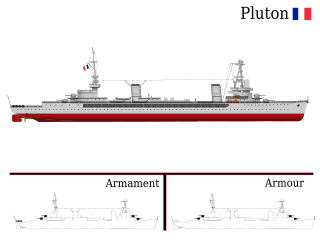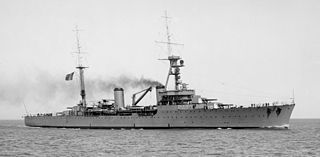 W
WAlgérie was the last treaty cruiser constructed for the French Navy. Designed and built in response to the Italian's Zara class of 8-inch gun cruisers, she was a totally new design and not based on the previous ships. The armoured caisson system used in Foch and Dupleix was abandoned in favour of a full armoured belt enclosing both the magazines and machinery spaces. She abandoned the unit propulsion system used previously and grouped her boilers forward leading to the reduction to a single funnel. She was one of the first vessels to utilize super heating boilers. Welding was used primarily in place of the normal rivetting in previous vessels. She maintained the same main armament but her secondary guns were increased to 100 mm guns. She served in the Mediterranean after entering service then searched for German surface raiders at the beginning of the war. She was at Toulon at the time of the Armistice and remained there until scuttled in November 1942.
 W
WDuguay-Trouin was the lead ship of her class of French light cruisers, launched in the early 1920s. She was named after René Duguay-Trouin. She patrolled the Mediterranean during the Spanish Civil War, and after the outbreak of the Second World War, she hunted Nazi pocket battleships before being interned after the Fall of France and until 1943. She then took part in Allied operations in the Mediterranean, supporting the Provence Landings and shelling Nazi and Fascist troops on the coasts of Italy until the end of the war. Duguay-Trouin then took part in the decolonisation wars in Algeria, and in Indochina.
 W
WDuquesne was the first of two Duquesne class cruisers built for the French Navy. During the interwar period she served in the Mediterranean while taking periodic cruises to show the Flag. During the war she was on blockade duty in the mid Atlantic then the Mediterranean. She was interred for three years at Alexandria, rejoining the war effort in 1943. Again assigned to blockade duty in the Mid Atlantic at Dakar. Post war she aided in the restoration of French Colonial rule in French Indochina until placed in reserve in 1947. She remained in reserve until condemned for disposal in 1955.
 W
WÉmile Bertin was a French fast light cruiser named after Louis-Émile Bertin, a 19th-century naval architect. She was designed to operate both as a minelayer and as a destroyer flotilla leader. The design was the basis for later light and heavy French cruisers, particularly the slightly larger La Galissonnière class of cruisers. This was the first French warship to use triple mountings for guns.
 W
WGeorges Leygues was a French light cruiser of the La Galissonnière class. During World War II, she served with both Vichy France and Allies. She was named for the prominent 19th and 20th-century French politician Georges Leygues.
 W
WGloire was a French light cruiser of the La Galissonnière class.
 W
WJean de Vienne was a French light cruiser of the La Galissonnière class. During World War II, she remained with Vichy France. She was named for Jean de Vienne, a 14th-century French knight, general and admiral during the Hundred Years' War.
 W
WJeanne d'Arc was a training cruiser built for the Marine Nationale during the late 1920s. She was designed both as a school ship and a fully capable warship. She saw service through the Second World War, escaping to Halifax after the fall of France and eventually joining the Free French forces before the end of the war. Post war, the cruiser resumed her duties as a training ship, being retired in 1964.
 W
WLa Galissonnière was the lead ship of her class of six light cruisers built for the Marine Nationale during the 1930s. She was named in honour of Roland-Michel Barrin de La Galissonière. During World War II, she served with Vichy France.
 W
WLamotte-Picquet was a French Duguay-Trouin-class light cruiser, launched in 1924, and named in honour of the 18th century admiral count Toussaint-Guillaume Picquet de la Motte.
 W
WLe Fantasque was the lead ship of her class of six large destroyers built for the Marine Nationale during the 1930s. The ship entered service in 1935 and participated in the Second World War. When war was declared in September 1939, all of the Le Fantasques were assigned to the Force de Raid which was tasked to hunt down German commerce raiders and blockade runners. Le Fantasque and two of her sister ships were based in Dakar, French West Africa, to patrol the Central Atlantic for several months in late 1939. They returned to Metropolitan France before the end of the year and were transferred to French Algeria in late April 1940 in case Italy decided to enter the war. She screened French cruisers several times as they unsuccessfully hunted for Italian ships after Italy declared war in June.
 W
WMarseillaise was a French light cruiser of the La Galissonnière class. During the Second World War, she remained with Vichy France.
 W
WSS Mexique was a French transatlantic ocean liner of the Compagnie Générale Transatlantique (CGT). She was launched in 1914 as Île de Cuba but when she was completed in 1915 she was renamed Lafayette.
 W
WMontcalm was a French La Galissonnière-class cruiser, named in honour of Louis-Joseph de Montcalm. During World War II, she served with both Vichy France and the Allies. It was commissioned in 1937, decommissioned in 1957, and finally scrapped in 1970.
 W
WPluton was a fast minelaying cruiser built for the French Navy in the late 1920s. She was also able to carry 1,000 troops on her mine deck as a fast troop transport. Shortly after completion she was modified and became a gunnery training ship, replacing the elderly armored cruiser Gueydon. Shortly before the beginning of World War II, she reverted to her original role and most of the gunnery training equipment was removed. She was sent to Casablanca, in French Morocco, when the war began to lay a minefield, but the order was cancelled a day later and she was ordered to disembark her naval mines. She exploded while landing her still-fuzed mines on 13 September 1939.
 W
WPrimauguet was a French Duguay-Trouin-class light cruiser built after World War I. During the Anglo-American invasion of French North Africa in 1942, she was burnt out and abandoned, having been subject to gunfire from a fleet led by the battleship Massachusetts, and repeated aerial attacks by SBD Dauntless dive bombers. She was named after the 15th century Breton captain Hervé de Portzmoguer, nicknamed "Primauguet".
 W
WSMS Regensburg was a light cruiser of the Graudenz class built by the German Kaiserliche Marine. She had one sister ship, SMS Graudenz. The ship was built by the AG Weser shipyard in Bremen, laid down in 1912, launched in April 1914, and commissioned into the High Seas Fleet in January 1915. She was named for the German town of Regensburg. The ship was armed with a main battery of twelve 10.5 cm SK L/45 guns and had a top speed of 27.5 knots, though in 1917 she was rearmed with seven 15 cm SK L/45 guns.
 W
WSuffren was the first vessel of the second group of 8-inch gunned, 10,000 ton Treaty Cruisers built for La Marine Nationale. She spent the interwar period with the two Duquesne-class cruisers until she was sent to French Indochina. Upon her return to the Mediterranean she rejoined the Duquesnes at Alexandria. She was interned there with the other units of the French Navy. She returned to the War in 1943 spending her time based at Dakar on blockade patrol. Post war she aided in the return of the French to Indochina until placed in reserve in 1947. In reserve she was used as a training hulk and barracks ship at Brest. She was renamed Océan in 1963 and finally stricken in 1972.
 W
WTourville was the second ship of the Duquesne class cruisers of the French Navy. During the interwar period she served in the Mediterranean while taking periodic cruises to show the Flag. During the war she was on blockade duty in the mid Atlantic then the Mediterranean. She was interred for three years at Alexandria, rejoining the war effort in 1943. Again assigned to blockade duty in the Mid Atlantic at Dakar. Post war she aided in the restoration of French Colonial rule in French Indochina until placed in reserve in 1947. She remained in reserve until condemned for disposal in 1962.